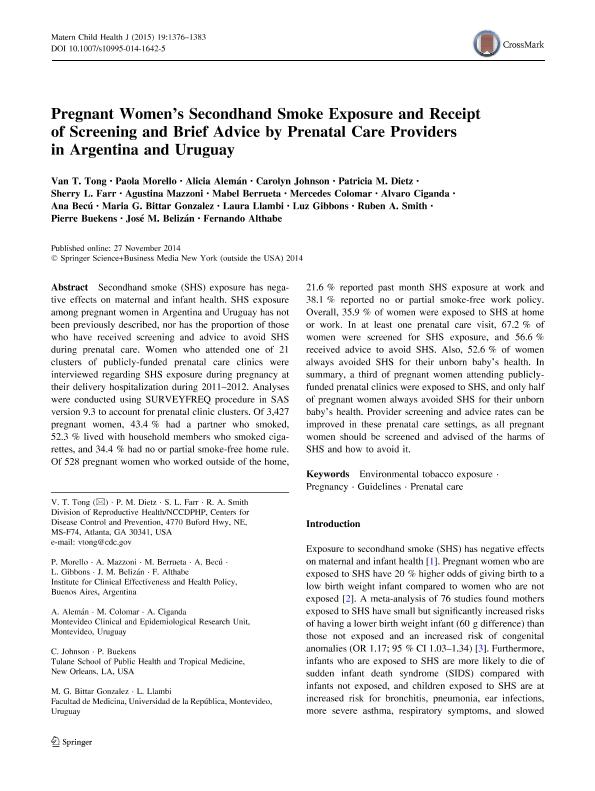Mostrar el registro sencillo del ítem
dc.contributor.author
Tong, Van T.
dc.contributor.author
Morello, Paola
dc.contributor.author
Alemán, Alicia
dc.contributor.author
Johnson, Carolyn
dc.contributor.author
Dietz, Patricia M.
dc.contributor.author
Farr, Sherry L.
dc.contributor.author
Mazzoni, Agustina

dc.contributor.author
Berrueta, Amanda Mabel

dc.contributor.author
Colomar, Mercedes

dc.contributor.author
Ciganda, Alvaro
dc.contributor.author
Becú, Ana
dc.contributor.author
Bittar Gonzalez, Maria G.
dc.contributor.author
Llambi, Laura
dc.contributor.author
Gibbons, Luz
dc.contributor.author
Smith, Ruben A.
dc.contributor.author
Buekens, Pierre

dc.contributor.author
Belizan, Jose

dc.contributor.author
Althabe, Fernando

dc.date.available
2018-05-21T15:37:05Z
dc.date.issued
2014-11
dc.identifier.citation
Tong, Van T.; Morello, Paola; Alemán, Alicia; Johnson, Carolyn; Dietz, Patricia M.; et al.; Pregnant Women’s Secondhand Smoke Exposure and Receipt of Screening and Brief Advice by Prenatal Care Providers in Argentina and Uruguay; Springer; Maternal and Child Health Journal; 19; 6; 11-2014; 1376-1383
dc.identifier.issn
1573-6628
dc.identifier.uri
http://hdl.handle.net/11336/45743
dc.description.abstract
Secondhand smoke (SHS) exposure has negative effects on maternal and infant health. SHS exposure among pregnant women in Argentina and Uruguay has not been previously described, nor has the proportion of those who have received screening and advice to avoid SHS during prenatal care. Women who attended one of 21 clusters of publicly-funded prenatal care clinics were interviewed regarding SHS exposure during pregnancy at their delivery hospitalization during 2011–2012. Analyses were conducted using SURVEYFREQ procedure in SAS version 9.3 to account for prenatal clinic clusters. Of 3,427 pregnant women, 43.4 % had a partner who smoked, 52.3 % lived with household members who smoked cigarettes, and 34.4 % had no or partial smoke-free home rule. Of 528 pregnant women who worked outside of the home, 21.6 % reported past month SHS exposure at work and 38.1 % reported no or partial smoke-free work policy. Overall, 35.9 % of women were exposed to SHS at home or work. In at least one prenatal care visit, 67.2 % of women were screened for SHS exposure, and 56.6 % received advice to avoid SHS. Also, 52.6 % of women always avoided SHS for their unborn baby’s health. In summary, a third of pregnant women attending publicly-funded prenatal clinics were exposed to SHS, and only half of pregnant women always avoided SHS for their unborn baby’s health. Provider screening and advice rates can be improved in these prenatal care settings, as all pregnant women should be screened and advised of the harms of SHS and how to avoid it.
dc.format
application/pdf
dc.language.iso
eng
dc.publisher
Springer

dc.rights
info:eu-repo/semantics/openAccess
dc.rights.uri
https://creativecommons.org/licenses/by-nc-sa/2.5/ar/
dc.subject
ENVIRONMENTAL TOBACCO EXPOSURE
dc.subject
GUIDELINES
dc.subject
PREGNANCY
dc.subject
PRENATAL CARE
dc.subject.classification
Medicina Critica y de Emergencia

dc.subject.classification
Medicina Clínica

dc.subject.classification
CIENCIAS MÉDICAS Y DE LA SALUD

dc.title
Pregnant Women’s Secondhand Smoke Exposure and Receipt of Screening and Brief Advice by Prenatal Care Providers in Argentina and Uruguay
dc.type
info:eu-repo/semantics/article
dc.type
info:ar-repo/semantics/artículo
dc.type
info:eu-repo/semantics/publishedVersion
dc.date.updated
2018-05-10T14:16:32Z
dc.journal.volume
19
dc.journal.number
6
dc.journal.pagination
1376-1383
dc.journal.pais
Estados Unidos

dc.description.fil
Fil: Tong, Van T.. Centers for Disease Control and Prevention; Estados Unidos
dc.description.fil
Fil: Morello, Paola. Instituto de Efectividad Clínica y Sanitaria; Argentina
dc.description.fil
Fil: Alemán, Alicia. Unidad de Investigación Clínica y Epidemiológica de Montevideo; Uruguay
dc.description.fil
Fil: Johnson, Carolyn. Tulane School of Public Health and Tropical Medicine; Estados Unidos
dc.description.fil
Fil: Dietz, Patricia M.. Centers for Disease Control and Prevention; Estados Unidos
dc.description.fil
Fil: Farr, Sherry L.. Centers for Disease Control and Prevention; Estados Unidos
dc.description.fil
Fil: Mazzoni, Agustina. Instituto de Efectividad Clínica y Sanitaria; Argentina
dc.description.fil
Fil: Berrueta, Amanda Mabel. Instituto de Efectividad Clínica y Sanitaria; Argentina
dc.description.fil
Fil: Colomar, Mercedes. Unidad de Investigación Clínica y Epidemiológica de Montevideo; Uruguay
dc.description.fil
Fil: Ciganda, Alvaro. Unidad de Investigación Clínica y Epidemiológica de Montevideo; Uruguay
dc.description.fil
Fil: Becú, Ana. Instituto de Efectividad Clínica y Sanitaria; Argentina
dc.description.fil
Fil: Bittar Gonzalez, Maria G.. Universidad de la República; Uruguay
dc.description.fil
Fil: Llambi, Laura. Universidad de la República; Uruguay
dc.description.fil
Fil: Gibbons, Luz. Instituto de Efectividad Clínica y Sanitaria; Argentina
dc.description.fil
Fil: Smith, Ruben A.. Centers for Disease Control and Prevention; Estados Unidos
dc.description.fil
Fil: Buekens, Pierre. Tulane School of Public Health and Tropical Medicine; Estados Unidos
dc.description.fil
Fil: Belizan, Jose. Consejo Nacional de Investigaciones Científicas y Técnicas; Argentina. Instituto de Efectividad Clínica y Sanitaria; Argentina
dc.description.fil
Fil: Althabe, Fernando. Consejo Nacional de Investigaciones Científicas y Técnicas; Argentina. Instituto de Efectividad Clínica y Sanitaria; Argentina
dc.journal.title
Maternal and Child Health Journal
dc.relation.alternativeid
info:eu-repo/semantics/altIdentifier/doi/http://dx.doi.org/10.1007/s10995-014-1642-5
dc.relation.alternativeid
info:eu-repo/semantics/altIdentifier/url/https://link.springer.com/article/10.1007%2Fs10995-014-1642-5
Archivos asociados
